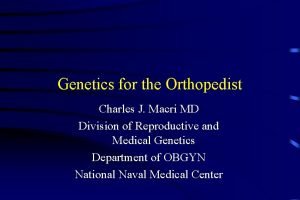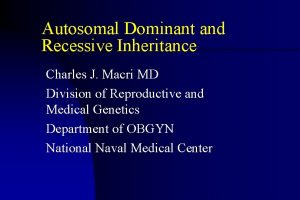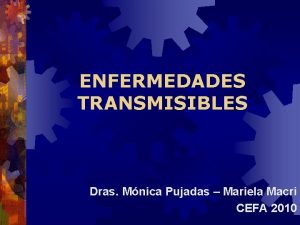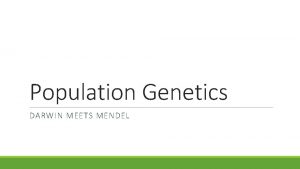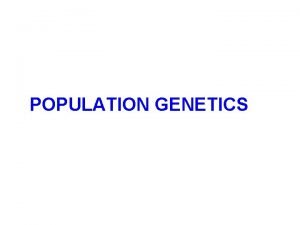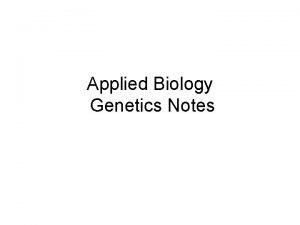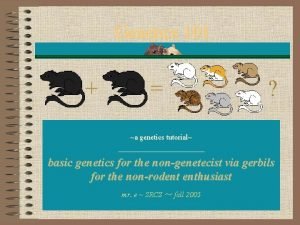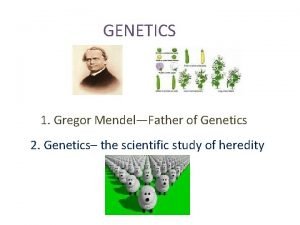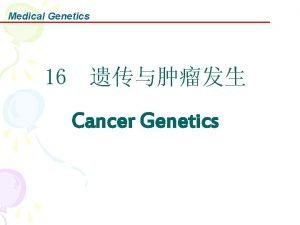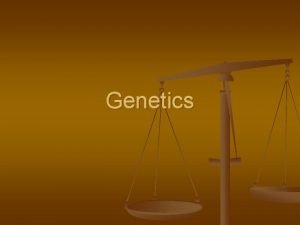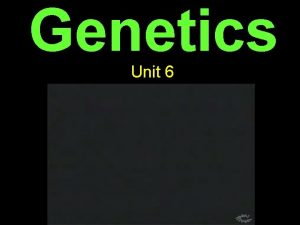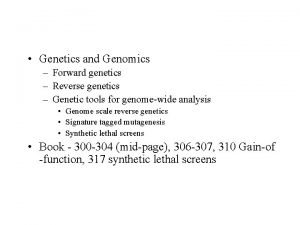Genetics for the Internist I Charles J Macri







































- Slides: 39

Genetics for the Internist - I Charles J. Macri, MD Departments of Obstetrics and Gynecology National Naval Medical Center] Bethesda Maryland

Why do we have to know this? • • • Board examination Residency examination Wardsmanship Intellectual stimulation Patient Care Your friends will ask you

Resources I have chosen • • Mayo Internal Medicine Board Review 1996 -1997 MKSAP 10 Current literature Computer databases - OMIM, NIH Genetics

Overview of Genetic Concepts • Basic human genetic principles – context of everyday clinical practice • relevance of human genome project – how genes behave in families and individuals • major forms of human inheritance • importance of clinical laboratory – ID of at risk individuals • clinical laboratory techniques available • management of hereditary disorders

Introduction • Chromosome Abnormalities • Patterns of Inheritance – Mendelian – Non-Mendelian • Mitochondrial mutations • Multifactorial inheritance • Presymptomatic diagnosis • Prenatal diagnosis • Molecular strategies

Inheritance • Chromosomal – numerical, structural, microdeletions • Single gene - CF, Sickle cell • Multifactorial – CHD, pyloric stenosis, Cleft lip/palate, NTDs • Triplet nucleotide repeats • Mitochondrial inheritance

Inheritance • UPD - Uniparental disomy • Imprinting - Prader willi, Angleman - 15 q 21 • Trinucleotide repeat sequences – Fragile X, Myotonic dystrophy, Huntington Disease, SBMA • Mitochondrial inheritance – MELAS, LHON Leber’s hereditary optic neuopathy

Hints that Genetic Cause is likely • Atypical age of onset - Angina before 50 • Episodic occurrences - Acute intermittent porphyria, periodic paralysis, recurrent syncope • Multiple occurrences - Bilateral tumors, multiple primary tumors, multiple cafe au lait spots (NF) • Seemingly unrelated conditions - presenting symptom plus MR, infertility or cong malf

Some examples of Genetic Disorders in IM • • Familial Long QT syndrome BRCA 1 - breast/ovarian CA susceptibility Neuofibromatosis 1 and 2 Alzheimer’s disease - apolipoprotein E locus Gaucher’s disease Osler-Weber-Rendu syndrome Hypertension

Will changes in Medicine affect Genetics? • Re-orientation of health care • Increased emphasis on preventive health – inherited risks • standardized reimbursement – encourage more extensive clinical genetics services • identification of heritable susceptibilities to common diseases

Biotechnology Industry • • marketing of clinical laboratory tests pharmaceuticals focusing attention on genetics health-care administrators, politicians, insurers

Social Forces • improved genetic education in public schools • emphasis on preventive medicine • increased expectation of health

Diagnosis of Genetic Disorders • Cytogenetic analysis – karyotype – clinical indications for cytogenetic analysis • Cancers arising from multiple genetic alterations • Metabolic and Biochemical testing • Linkage analysis of genetic disorders

Management of Genetic Disorders • Genetic Counseling • Avoidance strategies, Dietary supplements, and drug therapies • Organ transplantation and surgical interventions • Genetic therapy

Chromosome Abnormalities • occur in 1 in 800 live births • risk factors for autosomal aneuploidy: – maternal age > 35 years – having had an affected child

Down syndrome • most common autosomal aneuploidy syndrome in term infants • most serious consequence is mild to moderate mental retardation • most frequent heart defect is VSD or Atrioventricular canal defect • Males with DS are usually sterile, but females are fertile • Most persons with DS have trisomy 21

Down syndrome • Full trisomy - 94% • 21 trisomy/normal mosaicism - 2. 4% • Translocation cases - 3. 3% – about equal occurrence of D/G and G/G translocation

Down syndrome • 1 in 660 newborns overall • increased in women by age - 1 in 385 at 35 • Congenital heart defects - primary cause of early mortality – with CHD survival is 76% at 1 year – age 5, 61%; age 10, 57% • Increased incidence of leukemias • mean IQ - 24 in older patients

Sex Chromosome Aneuploidy Syndromes • 47, XXY (Klinefelter): small testes, infertility, tall eunuchoid body habitus • 45, X (Turner): short stature, lack of secondary sex characteristics, usually mentally normal, 30% risk of congenital heart defect (coarc of aorta) and bicuspid aortic valve – webbed neck, increased number of pigmented nevi, short 4 th or 5 th metatarsals/carpals

Other Chromosome Abnormalities • 34% of chrom abnormalities involve structural changes – deletions, duplication, inversions, translocations • Balanced translocations - usually phenotypically normal – may be at increased risk for miscarriages – children may have birth defects • Parents of all children with structural chromosome abnormality should have chromosome analysis

Fragile X-Linked Mental Retardation • fragile site on long arm of X - band q 27 • males with Fra. X: may be physically normal or have long, thin face, prominent jaw, large ears, enlarged testes, mild to profound MR • carrier females: phenotypically normal or mildly retarded and dysmorphic • Mutation - trinucleotide repeat (CGG) expanded into hundreds – direct DNA analysis most accurate

Patterns of Inheritance • Autosomal dominant • Autosomal recessive • X - linked dominant • X - linked recessive

Autosomal Dominant • • Ehlers-Danlos Hypertrophic cardiomyopathy Marfan syndrome Myotonic Dystrophy Nurofibromatosis - type 1 and 2 Osteogenesis imperfecta Tuberous sclerosis Von Hippel-Lindau Disease

EDS type I - AD condition • Features: velvety textured, hyperextensible, fragile skin • Joints are hyperextensible and prone to dislocation • Associated conditions: pes planus, scoliosis, degenerative arthritis, visceral diverticulosis, spontaneous pneumothorax • mitral valve prolapse in 50% • vascular rupture uncommon

EDS type II - mitis - AD • similar to I but milder • AD inheritance • mitral valve prolapse common

EDS type III - benign familial hypermobility • joint dislocations are common • skin hyperextensibility and scarring are minimal or absent • wide range of expression both within and between families • people with this disorder merge with the normal pop

EDS type IV - vascular type • genetically heterogeneous - AD, AR • most severe form / MVP common • deficiency of type III collagen synthesis or secretion in skin, aorta, uterus and intestine • rupture of large arteries, colon, gravid uterus • Angiography or other invasive procedures may precipitate vascular or organ rupture • Occasional: spontaneous pneumothorax, severe periodontal disease

EDS type V • • • X - linked recessive associated with lysyl oxidase deficiency skin hyperextensibility severe joint hypermobility - mild/moderate mitral and tricuspid valve prolapse or insuffiency may be present

EDS type VI - Ocular type • blindness from retinal detachment is complication • AD or AR - AR form sometimes seen with deficiency of procollagen lysyl hydroxylase • Severe scoliosis, joint dislocations, aortic rupture, GI hemorrhage can occur

EDS type VII • arthrochalasis multiplex congenita • extreme joint laxity and dislocations • AR form - defective conversion of procollagen to collagen • AD form - more common - structural abnormalities of half their alpha-2 chains of type I collagen which interfere with the conversion of procollagen to collagen

Hypertrophic Cardiomyopathy • AD, penetrance = 75% - 100% • Investigate all first degree relatives – EKG and ECHO • Children born to affected parent must be considered at risk and should be evaluated

Hypertrophic Cardiomyopathy • Course of disease is variable • Age of onset cannot be predicted • 50% of families with HC have defect in B-cardiac myosin heavy-chain gene on chromosome 14 • Genetic heterogeneity - other families have not shown this linkage to Chr 14

Marfan Syndrome • • • relatively common disorder of connective tissue incidence = 1 in 20, 000 AD with extremely variable expression 20% are new mutations Non-penetrance has never been documented

Marfan Syndrome • involves the musculoskeletal, cardiovascular and ocular systems • skeletal: tall stature, low upper: lower segment ratio, scoliosis or kyphosis, pectus deformities • ocular: subluxation of lenses, myopia and retinal detachment

Dislocation of Lenses - Differential DX • Marfan - occurs in 50 -80% of patients – lens frequently displaced upward • Homocystinuria • Weill-Marchesani syndrome • ALL patients with Marfan S must have – complete ophthalmologic exam – slit-lamp exam permits early detection of complications such as retinal detachment and glaucoma

Marfan Syndrome • life expectancy shortened by CV disease • most common CV manifestations are mitral valve prolapse and dilation of the ascending aorta • more than 80 of patients have abnormalities on echo • MVP is progressive • prophylactic antibiotics to prevent bacterial endocarditis is warranted

Autosomal Recessive • • Friedreich Ataxia Gaucher disease Glycogen storage disease Hemochromatosis Homocystinuria Pseudoxanthoma elasticum Refsum disease Tay-Sachs disease

X - Linked Recessive • Duchenne and Becker Muscular Dystrophies • Fabry Disease • Color blindness

Multifactorial Causation • disease or trait is due to environmental influences and polygenic predisposition • Isolated birth defects: congenital heart defects, cleft lip and palate, neural tube defects, pyloric stenosis • diseases that may have : DM, asthma, hypertension, coronary artery disease, atherosclerosis
 Charles macri
Charles macri Ami core measures
Ami core measures Charles manson childhood
Charles manson childhood Rita perspektiv
Rita perspektiv Toppslätskivling effekt
Toppslätskivling effekt Redogör för vad psykologi är
Redogör för vad psykologi är Bästa kameran för astrofoto
Bästa kameran för astrofoto En lathund för arbete med kontinuitetshantering
En lathund för arbete med kontinuitetshantering Bra mat för unga idrottare
Bra mat för unga idrottare Gumman cirkel
Gumman cirkel Svenskt ramverk för digital samverkan
Svenskt ramverk för digital samverkan Vad betyder lyrik
Vad betyder lyrik Etik och ledarskap etisk kod för chefer
Etik och ledarskap etisk kod för chefer Fredsgudinnan
Fredsgudinnan Vilken grundregel finns det för tronföljden i sverige?
Vilken grundregel finns det för tronföljden i sverige? Jätte råtta
Jätte råtta Förklara densitet för barn
Förklara densitet för barn Ministerstyre för och nackdelar
Ministerstyre för och nackdelar Sju principer för tillitsbaserad styrning
Sju principer för tillitsbaserad styrning Vem räknas som jude
Vem räknas som jude Nationell inriktning för artificiell intelligens
Nationell inriktning för artificiell intelligens Nyckelkompetenser för livslångt lärande
Nyckelkompetenser för livslångt lärande Ro i rom pax
Ro i rom pax Datumr
Datumr Borstål, egenskaper
Borstål, egenskaper Cks
Cks Personalliggare bygg undantag
Personalliggare bygg undantag Verktyg för automatisering av utbetalningar
Verktyg för automatisering av utbetalningar Vishnuiter
Vishnuiter Jag har gått inunder stjärnor text
Jag har gått inunder stjärnor text Inköpsprocessen steg för steg
Inköpsprocessen steg för steg Omprov cellprov
Omprov cellprov Strategi för svensk viltförvaltning
Strategi för svensk viltförvaltning Formel för standardavvikelse
Formel för standardavvikelse Informationskartläggning
Informationskartläggning Datorkunskap för nybörjare
Datorkunskap för nybörjare Tack för att ni har lyssnat
Tack för att ni har lyssnat Vad står k.r.å.k.a.n för
Vad står k.r.å.k.a.n för Läkarutlåtande för livränta
Läkarutlåtande för livränta Treserva lathund
Treserva lathund








































